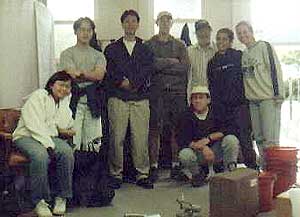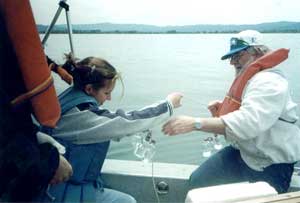|
|
|
|
|
|
|
|
|
|
Teaching Activities
|
|
|
|
MIC 120L -- MICROBIAL ECOLOGY LABORATORY
Spring 2000
Instructor: J.C. Meeks, 212 Hutchison Hall, telephone 2-3346
Email: jcmeeks@ucdavis.edu
Office hours: 11:00-12:00 Monday and 10:00-12:00 Wednesday and by appointment
Microbiology 120L is a 3 unit laboratory/discussion course on microbial ecology. The objectives of the course are to: (1) introduce the basic concepts of ecology, especially microbial ecology, and the role of microorganisms in maintaining steady state conditions in natural ecosystems; (2) examine in detail abiotic and biotic interactions within microbial populations in macro- and microhabitats; and (3) examine some aspects of environmental or applied microbial ecology. class in microbial ecology.
Highly Recommended (Required?) Textbook: R.M. Atlas and R. Bartha. 1998. Microbial Ecology: Fundamentals and Applications. Fourth Edition. Benjamin/Cummings Publishing Co., Inc.
Grading: Students will be held responsible for all material covered in the lectures and presented in class handouts. There will be one quiz, a midterm and a final examination. Grading will be based 5% on the quiz, 60% on the midterm and 35% on the final examination.
|
|
|
|
| Lecture |
Date |
Topic |
Reading
|
|
|
|
|
| Part I. General ecological concepts, enumeration and microbial activities.
|
|
|
|
|
| 1 |
Tu 4-4 |
Introduction to course. Language and laws of ecology, microbial diversity.
|
1-57 |
| 2 |
Th 4-6 |
Approaches to study, habitats-limits.
Introduction to enumeration.
|
281-331
218-280 |
| 3 |
Tu 4-11 |
Enumeration continued; counting individuals.
|
"
|
| 4 |
Th 4-13 |
Enumeration continued; counting populations.
|
" |
| 5 |
Tu 4-18 |
Enumeration continued; counting populations.
via signature molecules
|
" |
|
Wd 4-19 |
Optional review session on metabolism (PM).
|
|
| 6 |
Th 4-20 |
Microbial nutrition and energy metabolism in the
context of biogeochemical cycling
|
- |
| 7 |
Tu 4-25 |
Biogeochemical cycling-an overview
|
386-41 |
|
|
TAKE HOME QUIZ ON MATERIAL UP THROUGH NUTRITION.
|
|
| 8 |
Th 4-27 |
NO CLASS
|
|
|
|
|
Part II. Microbial communities; development and structure
|
|
|
|
|
| 9 |
Tu 5-2 |
Microbial community development and structure.
|
174-217 |
| 10 |
Th 5-6 |
Aquatic communites.
|
332-384 |
| 11 |
Tu 5-11 |
Aquatic communities.
|
" |
| 12 |
Th 5-13 |
Terrestrial communities.
|
" |
| 13 |
Tu 5-16 |
Terrestrial communities.
|
" |
|
|
MIDTERM EXAMINATION - TAKE HOME DUE IN ON 5-23 AT 9AM.
|
|
| 14 |
Th 5-18 |
Extreme environments-stable communities.
|
"
|
|
|
|
|
Part III. Microbial Interactions
|
|
|
|
|
| 15 |
Tu 5-23 |
Abiotic interactions: concepts and types of interfaces; biofilms
|
check index |
| 16 |
Th 5-25 |
Microbe-microbe interactions.
|
60-98 |
| 17 |
Tu 5-30 |
Microbe-plant interactions.
|
99-140 |
| 18 |
Th 6-1 |
Microbe-animal interactions.
|
141-172 |
|
|
|
|
Part IV. Applied aspects of microbial ecology
|
|
|
|
|
| 19 |
Tu 6-6 |
Microbial impact on the environment: Water quality control.
|
462-510 |
| 20 |
Th 6-8 |
Microbial impact on enrivronment:
Recalcitrant molecules/ bioremediation.
|
511-598 |
|
|
|
|
FINAL EXAMINATION: SATURDAY JUNE 10, 10:30AM - 12:30 PM
|
|
|
|
|
|
|
|
|
MIC 120L -- MICROBIAL ECOLOGY LABORATORY
Spring 2000
Instructor: J.C. Meeks, 212 Hutchison Hall, telephone 2-3346
Assistant: Francis Wong, 210 Hutchison Hall, telephone 2-7769, fcwong@ucdavis.edu
Microbiology 120L is a 2 unit laboratory class in microbial ecology, offered concurrently with Microbiology 120. The objectives of the laboratory are to introduce to students methods of quantitative measurements of microorganisms, their metabolic activities and interactions in laboratory model systems and in the field. There will be one field trip scheduled on 5/13, Saturday, for analysis of a microbial habitat.
Text: There is no textbook for the course. Laboratory and field experiments will be described in handouts.
|
|
|
|
Laboratory Schedule |
|
|
|
| Date |
Topic |
| Tu 4/4 |
Check in: Objectives, handling of data, lab reports and field trip.
|
| Th 4/6 |
Enumeration part I. Protein and chlorophyll analysis.
|
| Tu 4/11 |
Enumeration part II. Direct cell counts, viable plate counts, protein/chlorophyll analysis.
|
| Tu 4/13 |
Enumeration part III. ATP extraction, direct cell counts, and viable plate counts.
|
| Tu 4/18 |
Introduction to the use of radioisotopes.
Microbial activity part I: 1/2 of class measure CO2 fixation with 14C.
Enumeration part III (cont'd): 1/2 of class analyze ATP.
|
| Th 4/20 |
Microbial activity part I (cont'd): 1/2 of class measure CO2 fixation with 14C.
Enumeration part III (cont'd): 1/2 of class analyze ATP.
|
| Tu 4/25 |
Microbial activity part II. Nitrogen fixation via acetylene reduction.
1/2 of class analyze for ethylene produced.
|
| Th 4/27 |
Microbial activity part II. Nitrogen fixation via acetylene reduction.
1/2 of class analyze for ethylene produced.
|
| Tu 5/2 |
Activity data analysis. " ENUMERATION REPORT DUE."
|
| Th 5/4 |
Putah Creek field trip.
|
| Tu 5/9 |
Analysis of the Putah Creek samples.
|
| Th 5/11 |
Putah Creek data analysis. Preparation for Clear Lake Field Trip.
|
| SAT 5/13 |
Field trip to Clear Lake. Physiological and molecular ecology analysis of a
eutropic aquatic habitat
|
| Tu 5/16 |
Analysis of Clear Lake samples.
|
| Th 5/18 |
Analysis of Clear Lake samples. Molecular Ecology. "ACTIVITY REPORT DUE."
|
| Tu 5/23 |
Analysis of Clear Lake samples. Molecular Ecology.
|
| Th 5/25 |
Analysis of Clear Lake samples. Molecular Ecology.
|
| Tu 5/30 |
Analysis of Clear Lake samples. Molecular Ecology.
|
| Th 6/1 |
Analysis of field samples. Compile all field data.
"PUTAH CREEK REPORT DUE."
|
| Tu 6/6 |
Class discussion of Clear Lake data analysis.
|
| Th 6/8 |
Check out. "CLEAR LAKE REPORT DUE by 6/12."
|
|
|
|
GRADING
Grades are based on the written laboratory reports (80%) and instructor evaluation of effort and experimental technique (20%).
LAB REPORTS
Four reports are required in this class. A general outline of the report format is given below:
|
|
|
|
|
Points |
Rewrite |
| Enumeration |
50 |
Yes |
| Activity |
100 |
Yes |
| Putah Creek |
100 |
No |
| Clear Lake |
200 |
No |
|
|
|
|
The final points for a particular lab report will be the average of the original and the rewrite.
MIC 120L Class primary productively studies on Clear Lake, CA Spring 2000.
|
|
|
|
|
|

